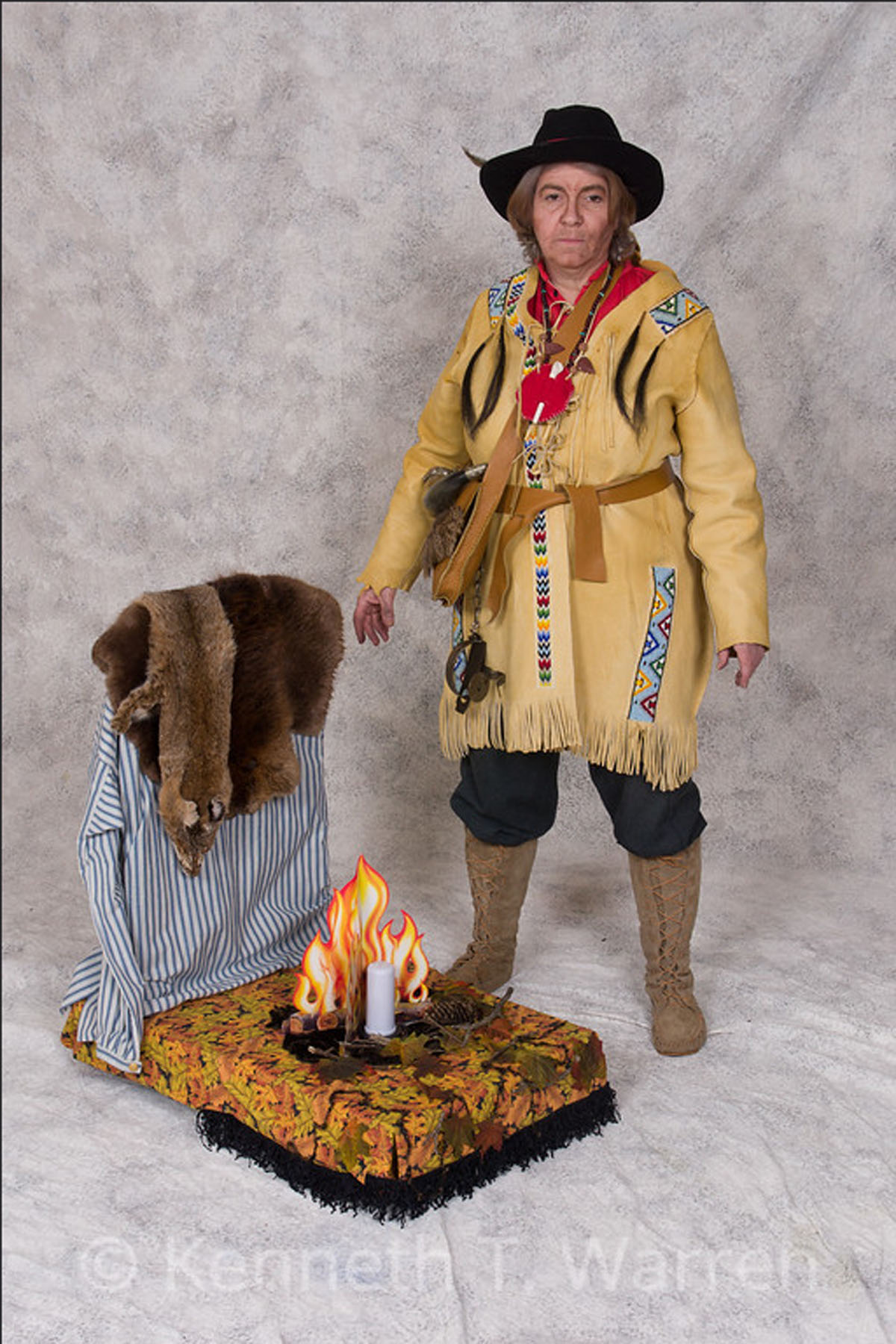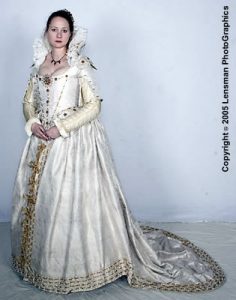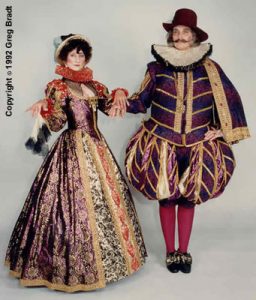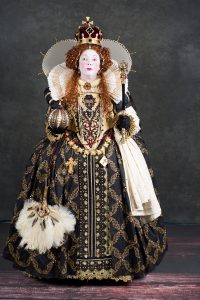CC37-H-00a: Masquerade Director
Competition Staff & Rules
Staff:
- Director: Byron Connell; Associate Director: Abigail Welsher
- Master of Ceremonies: Pierre E. Pettinger, Jr.
- Presentation Judges: Gypsy Ames, Jacqueline M. Ward, and Richard Hill
- Judges’ Clerk: Sébastien Bouchard
Rules:
Historical Masquerade
- The Costume-Con 37 Historical Masquerade celebrates the history of costume, including all cultures, periods, and types of dress. It recognizes creativity, scholarship, stage presentation, and workmanship skills in the context of historical clothing.
- To enter the Historical Masquerade you must be a member of Costume-Con 37, as must any additional participants.
- A “Historical costume” is based on clothing that was worn or could have been worn somewhere in the world through the end of December 1983.
- The rules for the Historical Masquerade follow the International Costumers’ Guild Guidelines for Ensuring Fair Competition. Please read them carefully. While similar to those for other masquerades, they are not identical to them.
- Masquerade Entrants Registration. All entries are highly encouraged to use the registration form on our website to pre-register, even if you only think you’ll have a costume completed in time. There will be at-con registration as well. You will be able to update or change your information until the on-site Historical Masquerade registration desk closes.
- Each entry should mark the appropriate era of the costume on the Registration Form. If each costume in a group entry has a different time period, mark all appropriate dates.
- At the con, entrants must check-in at the Historical Masquerade registration desk. Each entrant (every person who will be on stage) must sign a masquerade release.
Competition Categories
- The Historical Masquerade will have three categories of entry; Historical Dress, Historical Interpretation, and Ethnic Costume or Dress. Entries in all categories are eligible for Best in Class and Best in Show:
- Historical Dress is for a costume that is intended to look like it came from a particular period of history. This includes costumes copied from a specific artwork or surviving garment, original costumes meant to look as if they were designed and made during a particular period, and everything in between. It is acceptable to use modern approximations for period materials for reasons of availability, cost, or safety; such approximations should be noted in your documentation. Modern machine sewing is allowed.
- Historical Interpretation is for a costume that intentionally and visibly departs from the period on which it is based. It ought to be obvious to the viewer that this costume was not intended to be totally authentic. If the judges have to ask what makes your costume an interpretation, it probably belongs in Historical Dress.
- The distinction between these two categories is based on the costume’s intent, not its execution.
- Ethnic Costume or Dress is for a costume that would fall into a religious, racial, national, or cultural group’s specific form of dress. Entries in this category may be from any time period, including the present. If an ethnic garment is from the past and no longer worn by any of the above-listed groups, the entry is still considered ethnic costume. This category is one of reproduction, NOT interpretation. Therefore, requirements for design and creation techniques (e.g., sewing), choices of materials, and documentation are the same as for Historical Dress.
Skill Levels
- Skill levels (Young Fan, Novice, Journeyman, and Master) are intended to ensure that both inexperienced and experienced costumers have a reasonably equal chance to win awards.
- Young Fan: This level is limited to entrants younger than 13 years old (born after March 24, 2006) who are not part of an adult entry. It will be divided between entries made by a young fan and entries made by an adult that a young fan presents.
- Novice: The Novice level is for beginners to costuming. You may NOT enter at this level if you (1) have won two awards at the Novice level in a Costume-Con Historical Masquerade, (2) have won at a level more advanced than Novice in a Costume-Con Historical Masquerade, (3) compete at the Master level in Science Fiction and Fantasy Masquerades at Costume-Cons, Animé North, or World Science Fiction Conventions (ICG-recognized “international-level competitions”), (4) have a costume Laurel, or (5) are a professional. Professional is defined as someone who earns a majority of his or her income from fashion or costume, including university faculty members.
- Journeyman: The Journeyman level is an intermediate level to allow further development of costuming skills. You may NOT enter at this level if, at a Costume-Con Historical Masquerade, you (1) have won four awards at the Journeyman level, (2) have won an award at the Master level, or (3) have won Best in Show; or if you (4) have a costume Laurel or (5) are a professional (as defined above).
- Master: This is an open level. Anyone may enter. You must enter at this level if you are not eligible to enter as a Young Fan or at the Novice or Journeyman levels.
- Group entries should compete at the level of the group’s most experienced member who is an essential element of the entry. If in doubt, consult with the Masquerade Director.
- A contestant, including a Young Fan, may enter at a more advanced level than the one for which he or she qualifies. However, an entrant who then wins at that level may not subsequently compete at a lower level. If in doubt over the level at which to compete, consult with the Masquerade Director.
Awards
- Our judges will make awards in three areas: Documentation, Workmanship and Detail, and Stage Presentation.
- Documentation: Every entry must have some documentation. Documentation must be turned in to the Historical Masquerade registration desk by 8:00 p.m., March 22, 2019. If you are arriving at the con after that, please contact us well in advance.
- Basic documentation: The basic requirements include:
- Title of costume
- Entry category
- Name and address of the person responsible for the entry (or spokesperson for a group)
- Name(s) of designer(s) and maker(s)
- Brief identifying description of the costume’s historical period, geographic origin, social class, and so forth
- Bibliography of sources
- Basic documentation: The basic requirements include:
- Documentation: Every entry must have some documentation. Documentation must be turned in to the Historical Masquerade registration desk by 8:00 p.m., March 22, 2019. If you are arriving at the con after that, please contact us well in advance.
The “brief identifying description” should include evidence of the historical basis for the costume. This could be as little as one photocopy of a single picture with an identifying caption or it could be more comprehensive. Assume that the judges are not familiar with the costume(s). You may wish to begin with a brief statement of what you are trying to accomplish and your rationale for choosing the project.
-
-
- Advanced documentation: In going beyond the minimal requirements, your documentation might include the following:
- Pattern sources
- Photocopies of visual sources, such as artworks, costume drawings, and sketches, that you used
- Rationales for design and for choices of fabrics and colors
- Swatches of fabric and trim
- Your own photograph(s) of original historical garments or accessories
- Brief descriptions of any special skills or tools you used, such as shoemaking, weaving, or welding
- Outstanding documentation (basic or advanced) demonstrates a comprehensive knowledge of the historical source(s) on which a costume is based, with rationales for all elements of the costume, including undergarments, accessories, and minor details, and explanations for deviations from the norm of the period. It is organized logically and neatly, and presented attractively. Some contestants even go to the length of designing documentation in a style consistent with the costume.
- Advanced documentation: In going beyond the minimal requirements, your documentation might include the following:
-
Outstanding documentation should be brief, long enough to get your point across, but no longer than you need to demonstrate the historical basis of the costume. Please be concise. Text (not including bibliography and captions) is limited to no more than five 8½”x11” typed double-spaced pages per costume (Per person in a group entry). There is no page limit on captioned photographs and illustrations, fabric swatches or other samples, references, or bibliography. A caption need not be limited to only a few words; it may be a few sentences or even a brief paragraph.
-
-
- The following will not be accepted as a part of documentation: original sources, including books and paintings (make copies), slides, computer files, and videos (tape/CD/DVD).
- Workmanship and Detail Judging: This is your opportunity to let the judges admire your work up close. Before the show, each entry will meet by themselves with the panel of judges to show off the costume(s). Entrants will be expected to show the judges all necessary parts of the costume. If you want the judges to note especially an item or element of the costume, be prepared to point it out to them.
-
We recommend that you carry the costume to the prejudging, rather than wear it, so that the judges may handle and examine your work inside and out. However, if you decide to wear the costume to the meeting, be prepared to have the judges look down your top, under your skirt, or at your underwear.
This part of the competition is required of all entrants. Meeting time will be strictly limited. We will not know what the time limit will be until the con; however, it will probably be about five minutes and certainly no more than ten minutes per person. The schedule will depend on the number of entries received by close of registration. Contestants will have an opportunity to sign-up in advance at the Historical Masquerade registration desk for judging appointments.
-
- Stage Presentation: Here is your opportunity to complete your illusion before an appreciative audience and the judges. Entries with one to six persons will be limited to a maximum of 60 seconds on stage. Entries with seven or more persons will be allowed up to 90 seconds. Please keep in mind that these are maximum, not minimum, lengths of presentation. If you feel that the maximum allowed will not be enough time to show your presentation, the Masquerade Director will be willing to listen to your argument and possibly allow more time at their discretion. The Masquerade Director strongly believes in brief presentations; 30 seconds should be sufficient to present a one-person entry to the judges and audience.
- The Historical Masquerade’s philosophy is “excellence deserves award”; there are no predetermined minimum or maximum number of awards the judges may make. Entries will be judged against what the judges see as the award-winning standard. This means that you will not be competing against anyone else. The judges are not obliged to award Best in Class or Best in Show if, in their opinion, no entry meets the standards for those awards
- When the person wearing a costume is not its designer/maker, awards recognizing design, creation, or workmanship will be made to the designer/maker, not the wearer. However, awards for stage presentation will be made to the wearer.
Constraints on Presentations
- All the general stage presentation rules for Costume-Con 37 masquerades apply.
- Safety is our paramount concern. There will be absolutely no flame, fires, sparks, or other fire hazards on stage. Other special effects must be clearly described to the Masquerade Director and to the stage manager and tech crew at the tech rehearsal in order for us to determine that they are (1) legal and (2) safe. Strobe lighting, for example, has the potential to be harmful to members of the audience. Smoke or fog machines could set off the fire alarms.
- If your entry includes displaying a weapon, the Masquerade Director must clear it and your routine ahead of time in order to ascertain that it will not harm other entrants, the judges, or the audience. No sharp edges or points will be permitted. Before and after the show, weapons must be carried to and from the Green Room in secure wrappings and must be peace bonded. Weapons that shoot or eject projectiles will not be permitted. If you intend to point a weapon at other members of your entry or at the judges or audience, you must demonstrate in advance to the Masquerade Director that the weapon DOES NOT WORK.
- Entrants may not throw anything at the audience.
- Recorded Material. Music and/or narration or dialogue as part of your presentation must be pre-recorded, except for a script to be read by the MC.Provide your recordings as a file in the top-level directory on a USB drive at uncompressed CD quality (.wav). We cannot accept tape cassettes or CDs. Hand in two copies at the Historical Masquerade registration desk as early as possible so that the tech crew can program sound for the show. The copies should contain only the music and/or speech you want played AND NOTHING ELSE. Label your USB drive with the entry title and your name. We will make every effort to return your sound after the show. See the masquerade desk on Monday. If you have questions, please contact tech@costumecon37.org.
- There will be no microphones available to entrants; the only person permitted to speak from the stage is the Master of Ceremonies (MC). The MC will be happy to work with you in reading a short script or to interact with you during your presentation; however, keep in mind that you have only one minute on stage.
The MC will have only a small light on the podium under which to read scripts. Provide your script in black double-spaced type on white paper using at least 18-point letters in a plain and easy-to-read font. Put the title of your entry and your name at the top of the script. Please keep a script to no more than about 100 words.
- Entrants may not use substances, including make-up or costume elements that could turn rancid or be smeared on or stain other costumes. This is generally known as the “No Peanut Butter” rule. All parts of your costumes must leave with you.
- Each contestant may appear only once on stage. You may enter another costume, but it must be on another Costume-Con 37 member’s body.
- Costumes needing electric power must be self-contained – no extension cords.
- We discourage the use of radio-controlled or other wireless devices as part of an entry. We do not know what sort of interference will exist in the hall during the show. It would be unfortunate to base your entry on something that doesn’t work when you are on stage.
- The Historical Masquerade is rated PG-13; there may be children in the audience. No flagrant nudity; there must be some display of skill in creating and executing a design. The Judges will not award what Mother Nature created. Remember, no costume is no costume.
- No live animals (other than guide animals) may be used in the masquerade.
- Small children must be under the control of a responsible adult at all times (backstage as well as on stage).
- Costumes that have won major awards (excluding Honorable Mention) for presentation or workmanship at previous Animé North, Costume-Con, or Worldcon competitions are ineligible to compete for an award, but may appear Out of Competition. Commercially made costumes, purchased or rented, may be shown only Out of Competition.
- There is no prohibition against presenting costumes worn in the halls before the show.
- Following a presentation, the entrant(s), roadies, or ninjas must remove props left on stage in a single pass.
Tech Rehearsal: Entrants will be required to attend a tech rehearsal. This is an opportunity for the stage manager and the tech crew to work with you to assure that sound and lighting support your presentation. Entrants who do not participate in the tech rehearsal may not appear in the masquerade.
You need not wear costumes for the tech rehearsal; however, you should wear the shoes you will use for your presentation and any parts of your costume that will impede your movement or vision, or both. Please bring a part of the costume that represents its dominant color(s) for a lighting check.
The default lighting will be stage dark, lights rise on entry, fade to black at exit; other patterns may be arranged with tech.
Green Room: Come to the Green Room when it opens officially (probably two hours before curtain time). Check in with the person at the check-in table. You will learn your number in the running order and will be assigned to a den of entries just before and/or after you, where you will be in the care of a Den Mom. Go to your den, introduce yourself to the Den Mom assigned to you, and take a seat. Please stay there until it is time to go on stage.
Your costume must be completed before you get to the Green Room. No sewing, gluing, soldering, welding, other construction work or extensive make-up work cmay take place in the Green Room except the final assembly of large costumes and props or unexpected repairs. If you need anything, let the Den Mom assigned to you know. We plan to provide light refreshments and to have a staffed repair table should a costume need repairs. The repair table provides glue, safety pins, needles and thread, tools, basic makeup, and so forth. It is for last-minute repairs only.
Your Den Mom will see that your photo is taken by the official masquerade photographer and by the photographer taking reference photos for the judges. We expect that official photos will be available for purchase by you and other convention members, possibly the next day. Your Den Mom also will get you to the stage at the right time and in the correct order.
The Green Room and backstage area are intended for entrants, roadies, and masquerade staff only. Entrants are asked not to invite other friends or family into the Green Room. However, parents of Young Fan entrants are welcome to accompany their children in the Green Room.
Stage Assistance: Backstage, there will be stage “ninjas” (dressed in black) at the wings to help you up and down the stairs, move props on and off stage, and catch you if you stumble. You need to let us know how much assistance you need, especially if your vision is obscured by a mask or by not wearing your glasses, or if your costume limits your range of movement. The more assistance you need, the earlier you should let us know (preferably at the Historical Masquerade registration desk).
There also will be stage ninjas at the front and sides of the stage to try to stop you from stepping off the stage by mistake. If you hear someone shout “Stop!” during your presentation, do so; you are in immediate danger of falling off the stage! However, if you dance, run, hop, skip, or jump so fast that the ninjas cannot stop you, you are responsible for your own safety.
Entrants should surprise the audience. NEVER surprise the Masquerade Director, the MC, the Tech Director, tech crew, and the stage crew. No exceptions to the “never surprise the crew” rule will be permitted and entrants who attempt to do so will be disqualified. If you are planning something unusual or unique, please inform the Masquerade Director well in advance of the masquerade.
The Masquerade Director has the full authority to eliminate anyone from the masquerade on the grounds of bad taste, danger to self and/or others, violation of the above rules, or any other reason deemed sufficient. There is no appeal. Offers of cash and/or chocolate will not help.
Photography:
- Official Photography: The official masquerade photographer will photograph your costume(s) before the show starts. This is not optional.
- Fan Photography: Fan photography may take place from the audience during the show, using available light (not flash). For the safety of those on stage, use of flash photography during the show is strictly prohibited. The Masquerade Director will stop the show and have the house lights turned on until those using flash have been ejected from the hall. In addition there probably will be an on-stage “photo run” for fan photographers after the last entry’s presentation (while the judges are deliberating); if so, your participation would be optional.
If you feel any or all of these rules don’t apply to you, you are wrong. If you feel you need an exception, you must convince the Masquerade Director long before the masquerade. Offers of cash and/or chocolate will not help here either.
Registration
Online registration is closed. Please see the Masquerade desk at con for more information.
If you have any questions, please contact: [Removed]
Tips for a Successful Masquerade
- Before the show, get some sleep!
- Before the show, please eat. If you want to faint after you’ve been on stage, fine; however, we don’t want you to pass out from hunger or low blood sugar in the Green Room or on stage.
- Before the show, rehearse, rehearse, rehearse.
- Remember, this is a costume show, not a talent competition. Never bore the audience.
- Don’t forget to enjoy yourself. Have fun!
Awards
Historical
Worksmanship
- Novice
- Award for Shoes and Machine Embroidery: Robe de Cour
- Best in Class, Novice: Victorian Shaundi
- Journeyman
- Best Authenticity in Textiles: Senatus Populusque Romanus
- Best Embroidery: 18 th Century Belle
- Honorable Mention for Hand-Stitched Gloves: Robin with Green Sleeves
- Award for Attention to Detail: Supercalifragilisticexpialidocious Holiday
- Best in Class, Journeyman: A World of My Own
- Master
- Best Dye Work: A Tribute to the Geisha of Japan
- Best Metal Work, Vicky Assarattanakul and Catherine Cherwin: The Devonshire Ball
- Best Embroidery and Pearl Work, Carol Inkpen / Russian Lady: Honey, I’m Home!
- Best Ribbon Work Award, Nora Mai: Honey, I’m Home!
- Piping and Sleeves Award, Andrea Lewis: Honey, I’m Home!
- Honorable Mention, for Ruching and Pleating: Robe a la Francaise
- Best in Class, Master: Returning to Camp: A Fur Trapper of the American West
- Best in Show
- Duchess Louisa as Zenobia: The Devonshire Ball – Maral Agnerian
Documentation
- Novice
- Honorable Mention for Documentation: Robe de Cour
- Journeyman
- Attention to Details: Supercalifragilisticexpialidocious Holiday
- Best in Class, Journeyman: A World of My Own
- Master
- Most Appealing: The Devonshire Ball
- Judges’ Choice for Organization and Content: Robe a la Francais
- Best in Class, Master: Returning to Camp: A Fur Trapper of the American West
- Best In Show
- Senatus Populusque Romanus
Presentation
- Novice
- Best Character: Victorian Shaundi
- Best in Class, Novice: Robe de Cour
- Journeyman
- Honorable Mention for Military Stature: Senatus Populusque Romanus
- Honorable Mention for Stage Presence: Spring Promenade, 1879 Style
- Best Adaptation: 18 th Century Belle
- Best Historical Super Hero: Robin with Green Sleeves
- Best in Class, Journeyman: Supercalifragilisticexpialidocious Holiday
- Master
- Best Performance: A Tribute to the Geisha of Japan
- Sweetness and Light Award: Robe a la Francaise
- “To Drink or Not To Drink” Award: What Foul Ball Through Yonder Window Breaks(Part 2)
- Deck the Halls Award: Honey, I’m Home!
- Best in Class, Master: Returning to Camp: A Fur Trapper of the American West
- Best in Show
- The Devonshire Ball




